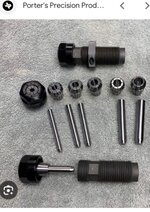TaperPin
WKR
- Joined
- Jul 12, 2023
- Messages
- 6,056
Thanks for all the replies. My problem (with damn near everything) is that I over-analyze and then I like to tinker to see if I optimize. It's not like my current process isn't working. My SDs are usually 8-14, depending on which load I'm currently using, so they're not horrible but I'd like to see if I just attain more consistency. I've upgraded my scale to see if that helps, as well.
I may give the mandrels a shot, if for no other reason that I'm not crazy about the hornady spindle.
Since you like to tinker, a die body that holds different size gauge pins as mandrels allows you to have any size for any caliber with one die. Gauge pins are only $5 each or so on eBay and you will need to chuck them in a drill to chamfer one end with sandpaper. Google gauge pin mandrel body reloading to see who is making them now.

